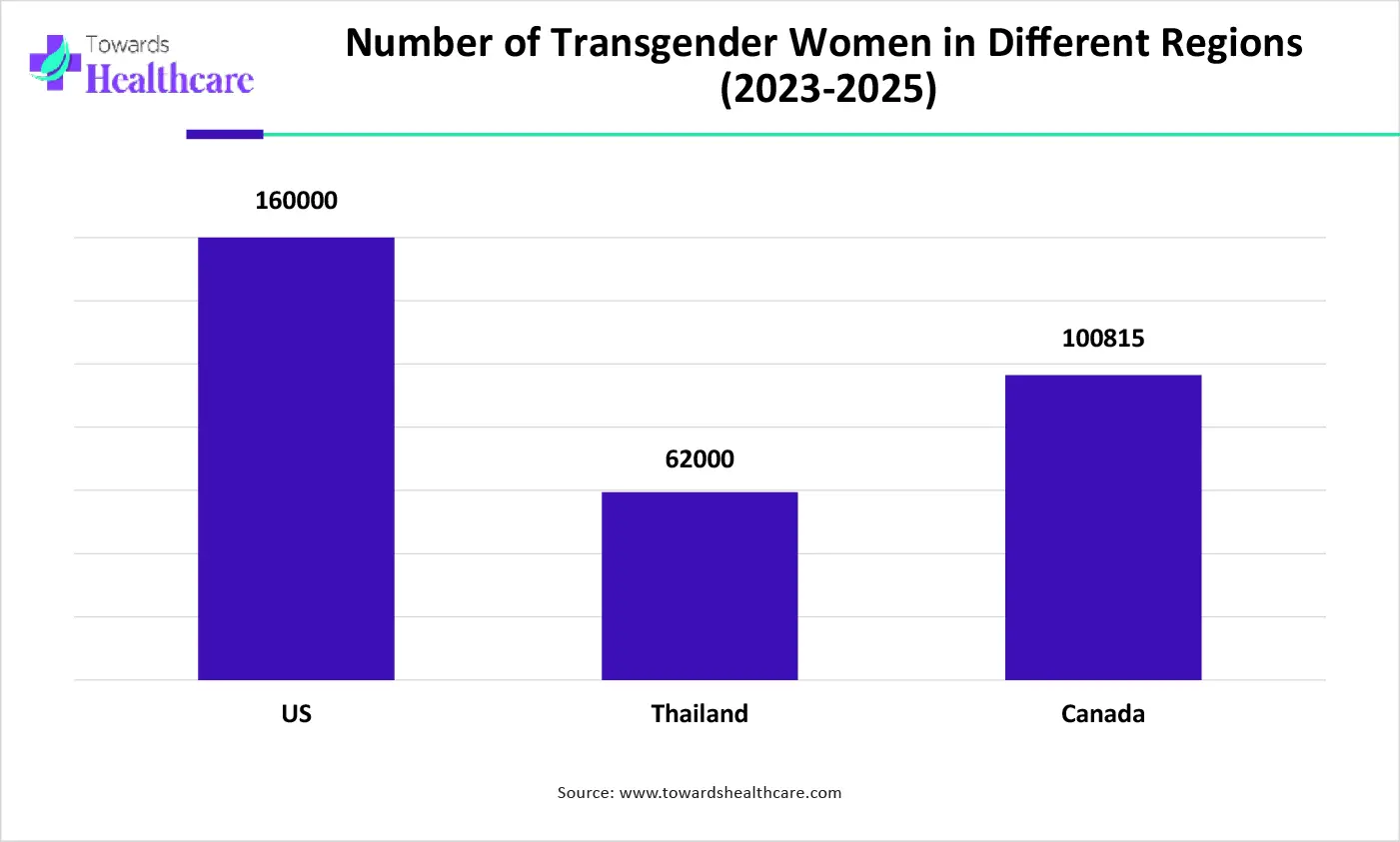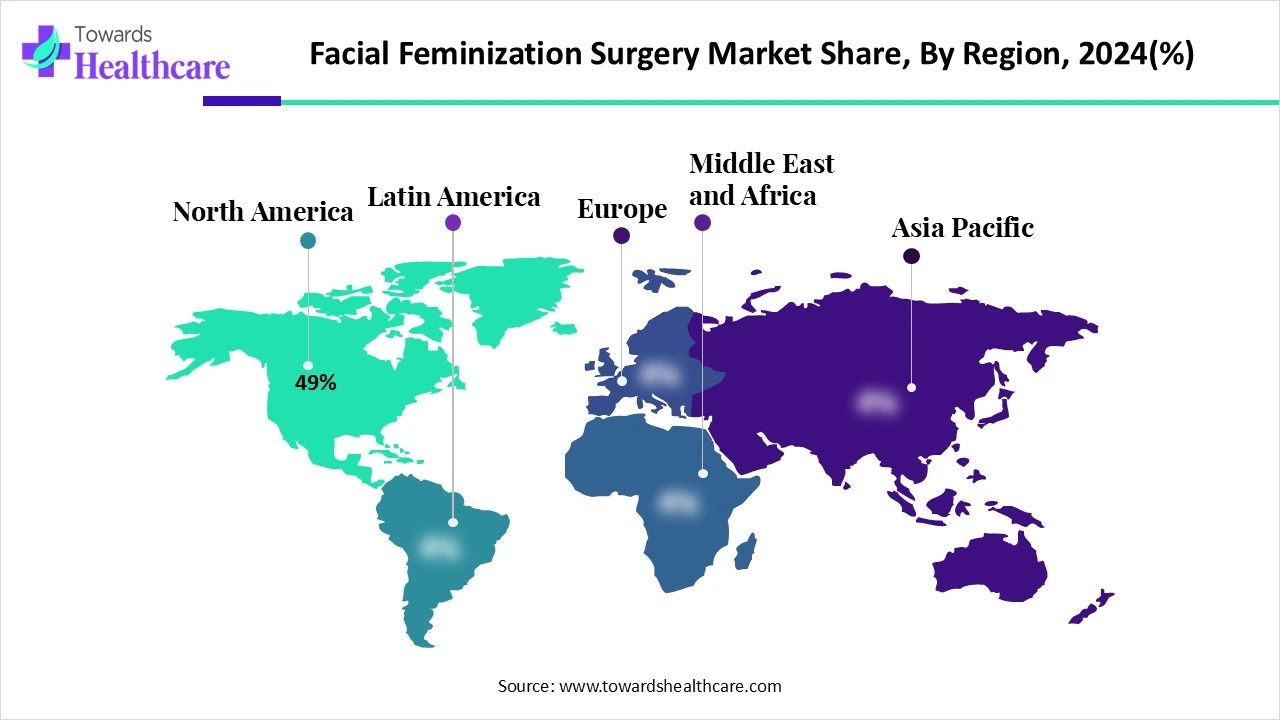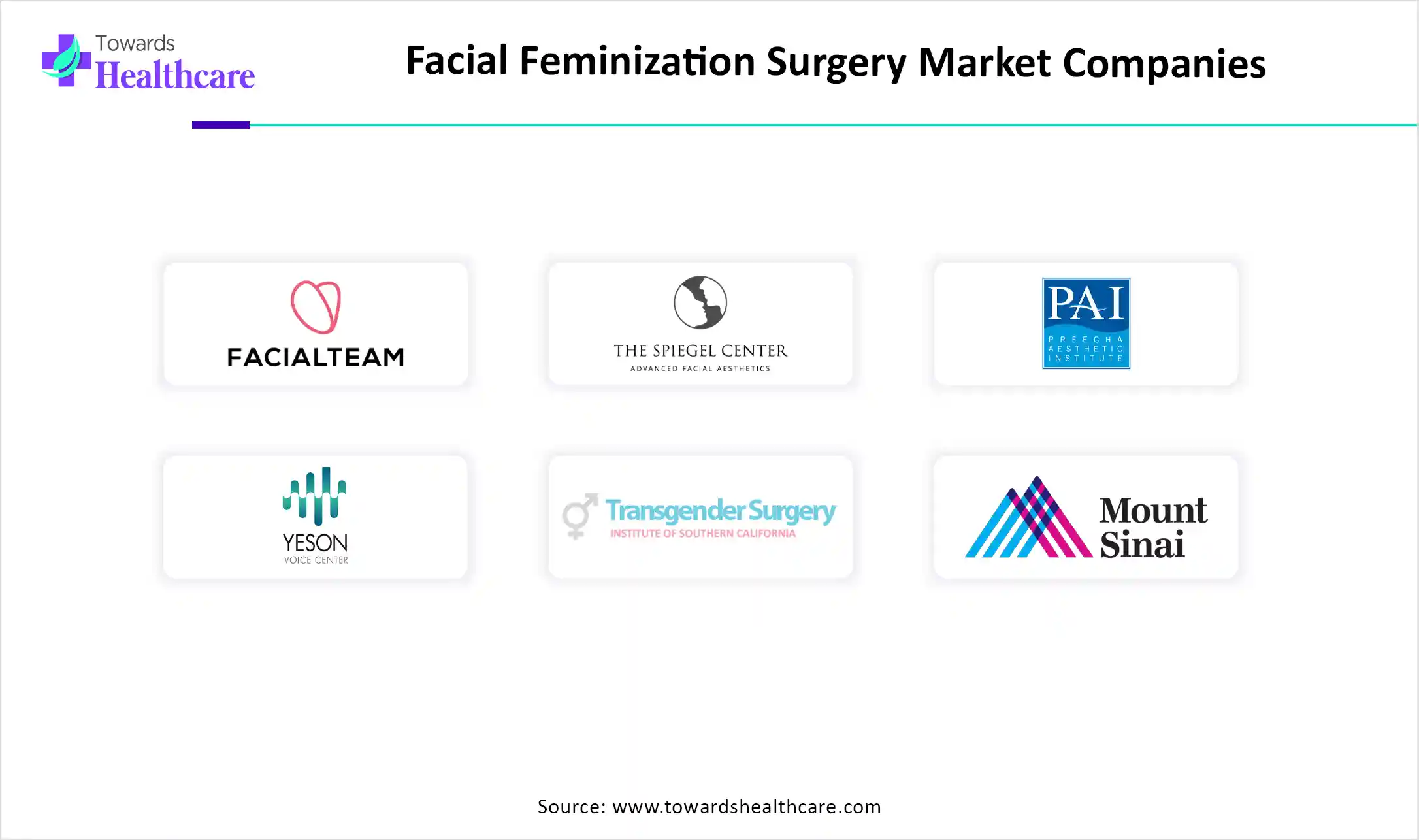November 2025

The facial feminization surgery market is on an upward trajectory, poised to generate substantial revenue growth, potentially climbing into the hundreds of millions over the forecast years from 2025 to 2034. This surge is attributed to evolving consumer preferences and technological advancements reshaping the industry.
The global facial feminization surgery market has adopted FFS in different regions, addressing major growth by increasing awareness and acceptance of gender-affirming care, and growing cases of dysphoria are highly demanding for FFS procedures. Along with this, the broad application of medical tourism in Thailand, India, and South Korea, with inexpensive approaches, is accelerating the market. In the future, many surgical techniques, including bone remodelling, soft tissue manipulation, and minimally invasive approaches, and the adoption of 3D modeling will expand the demand for FFS and the market as well.
The facial feminization surgery market encompasses surgical procedures designed to alter typically masculine facial features to bring them closer in shape and size to typical female facial characteristics. Common procedures include forehead contouring, jaw and chin reshaping, rhinoplasty, and tracheal shave, among others. FFS is primarily sought by transgender women and gender non-conforming individuals as part of gender-affirming care. The market is growing due to increasing gender-affirming healthcare access, supportive regulations, social awareness, and medical tourism. Nowadays, surgeons are increasingly using different craniofacial techniques to reshape bone structure and achieve feminization.
In the 2025 era, AI is playing a major role in various surgeries, including FFS, in which it is driven by breakthroughs in image analysis, predictive analytics, and augmented reality. As AI assists in accelerating surgical accuracy, optimizing patient results, and streamlining the complete FFS process, it is widely adopted. As well as AI-driven tools can examine facial features and anticipate surgical results with supporting to development of personalized treatment plans. Also, AI is generating 3D models and simulations to help patients visualize potential outcomes and understand the surgical methods.
Growing Acceptance of Gender-Affirming Care and Technological Advancements
Around the world, the facial feminization surgery (FFS) market is fueled by the rising awareness and acceptance of transgender identities, along with the significance of gender-affirming care. Besides this, the adoption of FFS is providing to identify gender, mainly decreasing the psychological distress linked with gender dysphoria. However, consistent advancements in surgical techniques, including computer-aided planning and accurate bone contouring, have boosted the precision and efficiency of FFS.

The graph displays the number of transgender women in the US, Thailand, and Canada. Across the world, rising awareness and acceptance of gender-affirming care are boosting demand for advanced FFS procedures. As well as increasing cases of dysphoria, there is a demand for FFS procedures to enhance self-esteem, physical appearance at the public level.
Expensive Procedures and Surgical Complications
Major challenges involved in the facial feminization surgery market are its expensive procedure, with costs ranging from $4,500 to $100,000 based on the number of procedures and region across the globe. Also, FFS caters to another obstacle related to its risks and complications, including bleeding, infection, nerve damage, and unsatisfactory healing. Additionally, some ethical concerns are generating barriers for FFS, which argue that it reinforces societal beauty standards and may not be a strong way to address gender dysphoria.
Adoption of Multidisciplinary Approaches and Innovative Surgical Techniques
The facial feminization surgery market has been generating various opportunities for future expansion, such as R&D department is emerging novel surgical techniques including bone remodelling, soft tissue manipulation, and minimally invasive approaches. Moreover, advanced imaging and 3D modeling are emphasizing to customize of FFS procedures to individual patient needs and favourable results. Along with this, robust collaborations between surgeons, endocrinologists, psychologists, and other specialists are enabling comprehensive care.
By procedure type, the forehead contouring/brow reduction segment held nearly 27% of the revenue share of the facial feminization surgery market and was dominant in 2024. The segment is impelled by rising adoption in reducing gender dysphoria by acquiring a more harmonious and feminine facial appearance. As well as enhancement in surgical techniques like the use of burring, frontal sinus setback, and bone plating, are accelerating the precision and more effective results of these kinds of procedures.
On the other hand, the comprehensive full-face surgery segment is estimated to show rapid growth during 2025-2034. As this segment comprises a combination of procedures like forehead contouring, brow lift, rhinoplasty, cheek augmentation, jaw and chin contouring, and tracheal shav e is increasingly showing positive results in patients, such as enhancing patients' self-esteem, social life, and mental health, reducing psychological distress, anxiety, and depression.
By gender-affirmation segment, the transgender women segment dominated with a major share of ~72% in the market in 2024. Primarily, FFS provides well-designed procedures to modify facial features to align with a more feminine appearance, which is vital for gender affirmation and optimizing the quality of life for transgender women, driving the segment expansion.
The male-to-female crossdressers/others segment is predicted to register the fastest growth due to rising visibility and elective procedures. With novel creations in tissue engineering and regenerative medicine, we are paving the path for great natural and functional outcomes, with rising demand for FFS.
The 30–44 years segment led the global facial feminization surgery market in 2024. The population in 30–44 years is experiencing well-established careers with significant financial stability, and also this group is widely looking for alignment of their physical appearance, gender identity, the FFS fueling the demand for this.
The 18–29 years segment is anticipated to expand rapidly during 2025-2034. However, this group is highly seeking for alleviation of gender dysphoria by highlighting the physical characteristics which are resulting in distress and discomfort relevant to the individual's gender identity. Moreover, the group is emphasizing physical appearance, and raising self-esteem at the public level is propelling the demand for FFS and other surgeries.
By end user, the specialized facial surgery clinics segment held the biggest share of ~53% in the market in 2024. This clinic provides a devoted team to focus on transgender healthcare, with a safe and improved environment, with expertise in FFS procedures and post-operative care, which has majorly impacted the segment and overall market expansion.
Whereas the medical tourism facilities segment is predicted to grow rapidly, due to affordable procedures in a few countries, especially in Thailand, India, Mexico, and Spain, leading to a cost-effective approach. With presence of specialized and experienced surgeons in many regions is boosting the segment approach.

Due to the 49% revenue share of North America in the market in 2024, results in dominated region. In North America, unified healthcare systems, such as Kaiser Permanente, are evolving comprehensive gender care programs that enable coordinated care, including psychiatric services, primary care, and social work, to facilitate access to FFS. Furthermore, growing medical tourism by many individuals to this region for FFS is looking for skilled professionals, mainly driving the overall market growth.
The U.S is a major country in North America, experiencing crucial growth due to high procedure volumes, insurance reimbursements for gender-affirming care, and specialized surgeons. As well as growing use of FFS coupled with aging face surgery in older patients to restore sexual dimorphism, further propelling demand.
For instance,
Canada possesses an advanced healthcare infrastructure with specialized clinics and experienced surgeons is widely influencing the market development.
For this market,
As per research, Asia Pacific is estimated to show the fastest growth during 2025-2034, by contributing major factors such as growing affordable procedures compared to other regions, with increasing medical tourism. Along with this, enhanced social awareness and acceptance for transgender individuals, especially in countries like Thailand, India, and South Korea, are fueling demand for FFS approaches with advanced techniques.
South Korea is a major leader for FFS, as it provides a robust cultural emphasis on self-improvement, with accelerating awareness and acceptance of transgender population, and enhanced access to healthcare services for transgender procedures, which are broadly influencing demand for FFS in this region and across the globe.
Japan is a major region where cosmetic and plastic surgery procedures are seeing a rise, along with upper face feminization procedures, including forehead reduction, orbital shaving, and hairline advancement, are impelling demand for FFS. As well as rising male-to-female gender affirmation surgery, assisting in raising the use of FFS procedures in Japan’s population.
Europe is experiencing significant growth in the facial feminization surgery market. Due to the rising emergence of specialized centres which are offering a wide range of gender-affirming procedures, including FFS, as well as growing investments in R&D focused on novel surgical techniques and addressing the unique needs of transgender individuals, is boosting innovation and appealing to more patients.
German patients prefer advanced surgical devices used in FFS; also, the increasing adoption of robotic-powered surgical devices in FFC with raised precision and control is resulting in enhanced results. These advancements are accelerating the healthcare access are driving demand for FFS procedures.
The UK population is adopting surgical techniques to develop aesthetic parameters, such as to achieve a natural appearance, and improve individual outcomes. Also, the region is developing specialized clinics and surgeons with expertise in FFS, to complete personalized requirements and enhance overall care.
For instance,

By Procedure Type
By Gender-Affirmation Segment
By Age Group
By End User
By Region
Market insights predict the global lipid nanoparticle manufacturing industry will increase from USD 400 millio...
According to market projections, the global pharmaceutical inspection machines market, valued at USD 0.96 bi...
Around the world, the sex-based drug development market is driven by the rising approaches to sex-based differ...
November 2025
November 2025
November 2025
November 2025